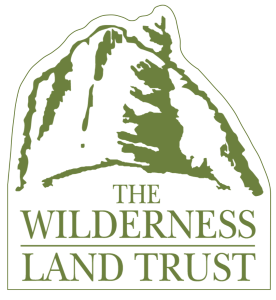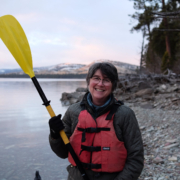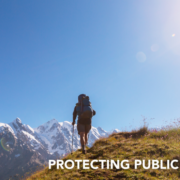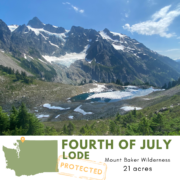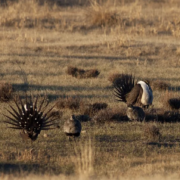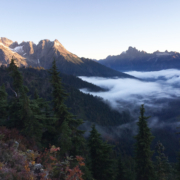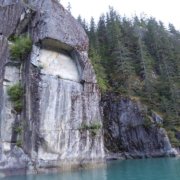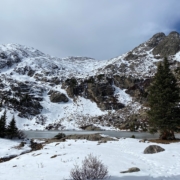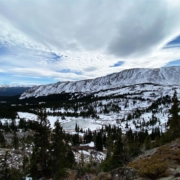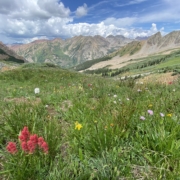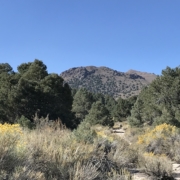Tag Archive for: Wilderness
Protecting public access
February 24, 2023- It is not an uncommon story across the West for access to public lands through private property to be withdrawn by the private landowner. In many cases the agreements between landowners and federal or state agencies to allow public access date back decades and were established with a handshake rather than a legal easement. So, as properties change hands, passed down through a family or sold, attitudes about allowing the public on trails or along rivers can shift. In some cases this has led to trail systems being closed, shutting hikers out of a whole section of National Forest.
Of course, as property owners, it is their right to decide how their land is used and who has access to it. So, one of the best solutions for ensuring continued public access is to work with willing sellers to purchase the property and transfer it to public ownership to be incorporated into the wilderness area. Through the years the Trust has protected public access across private inholding in this way throughout the West. Recently, projects in Colorado’s Weminuche Wilderness and Mount Massive Wilderness and Oregon’s Hells Canyon Wilderness protected popular trails, and a project in the Castle Crags Wilderness of California opened up access for climbers to a new part of the wilderness area.
Public access is just one of the characteristics of wilderness we work to protect. But for anyone who can remember their first time reaching a wilderness boundary sign on a trail or their first time seeing the night sky shining more brightly than ever before, you how powerful these experiences in wild places can be. There are people who believe wilderness is important and should be protected who have never stepped foot in it. But to experience it for yourself and form your own relationship with it is the best way to become an advocate for it. We believe that wilderness is for everyone: whether you’ve been going there your whole life or are going there for the first time; whether your family has a generations long connection with it or you are the first generation to experience it; whether you’re an expert at hiking, camping, fishing, hunting, paddling, or horse packing, or you’re a beginner. So as we work to protect public access in wilderness across the West, it truly is for everyone.
The Value of Conservation in the Mount Baker Wilderness
February 10, 2023- The Wilderness Land Trust recently completed the purchase of 21 acres of private property within Washington’s Mount Baker Wilderness.
Within this 21-acre property, high in the alpine, sits one of the remaining 13 glaciers in the Mount Baker Wilderness. Glaciers across the North Cascades have been steadily losing volume over the last several decades. As glaciers shrink due to a changing climate, the ecosystems that depend on them become increasingly vulnerable. We must protect them from stressors like development to assure their continued resilience.
The first law of ecology is everything is connected. During their normal annual cycles of accumulation and melt, glaciers act as reservoirs of water that persist throughout the summer, creating perennial steam habitat and water sources for plants and animals. Their runoff is also important to downstream water temperatures, small variations of which can have huge impacts on the ecosystem, including salmon spawning grounds.
The value of protecting this little 21-acre property high on the slopes of the Mount Baker Wilderness flows downstream just as its runoff does. It is connected to the larger landscape around it through a web of actions and reactions, which we are a part of. A recent study found the Mt. Baker-Snowqualmie National Forest provides $30 billion worth of ecosystem services that we depend on. These are things like the clean air and clean water which sustain life. Every dollar invested in the Forest returns over $3,000 in ecosystem services, making the purchase and protection of this property a sound investment for future generations.
Enjoy the view from the Fourth of July Lode property
Unifying the Bodie Hills Landscape
January 27, 2023-
This week The Wilderness Land Trust completed the transfer of 1,698 acres of sagebrush steppe in the eastern Sierra to public ownership.
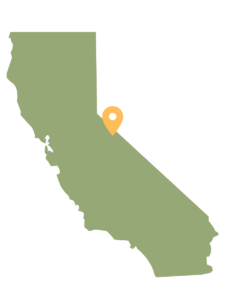 Located in the Bodie Hills, just east of Yosemite National Park, the property stretches across five parcels, dispersed throughout a large ranch holding.
Located in the Bodie Hills, just east of Yosemite National Park, the property stretches across five parcels, dispersed throughout a large ranch holding.
The Bodie Hills have some of the highest ecological intactness and species richness in the region, and are ranked in the top 10% of unprotected BLM lands in California for biodiversity. Despite the ecological importance of the region, it is a patchwork of private property and public lands managed by the Forest Service and Bureau of Land Management with three Wilderness Study Areas covering much of it. Wilderness designation efforts, such as those in the Bodie Hills, are often hindered by the presence of private land fragmenting the landscape as it creates an inability to control critical habitat components to assure the viability of a designation.
Since we began our work in the Bodie Hills in 2006, the Trust has purchased five large properties there totaling just over 7,000 acres. This is the third of them to be successfully transferred to public ownership. Thanks to the support of and partnerships with local conservations groups and tribes, we are steadily unifying ownership in the area, removing piecemeal management and fragmented habitats. It won’t be solved overnight, but the cumulative impact of almost twenty years of work and your support is moving us closer to the goal of protecting this important landscape.
Protecting the Mount Baker Wilderness
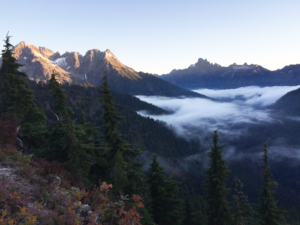
Morning valley mist in the Mount Baker Wilderness
April 8, 2022 – The Mount Baker Wilderness is named after the fourth highest summit in the state of Washington – the iconic 10,778 ft. Mount Baker. This beautiful and rugged mountain range in the North Cascades is lush with wildflowers, huckleberries and blueberries in the summer months to support a rich habitat for bears, elk, mountain goats and deer.
In 2018, a 38-acre property within this designated wilderness was donated to The Wilderness Land Trust to safeguard its extensive natural resources. We have been working diligently to get the property ready to transfer to public ownership ever since.
The first step was to remove an old cabin on the property. This demolition took many trips to the property and the hands of many dedicated volunteers, a process that was generously supported by the previous landowner.
However, the property was still not ready for transfer because the land was also protected by a conservation easement. The United States Forest Service (USFS) cannot accept title to a property where others hold a right. In this case, the Whatcom Land Trust held a right to the property through the conservation easement.
With the help and creativity of the Whatcom Land Trust and the USFS, we found a path forward and resolved this issue.
We are so pleased to share with you that this property has now been officially transferred to the public for permanent protection as part of the surrounding Mount Baker Wilderness. Sometimes it takes several years and many steps before we can transfer an acquired property. In this case, the process took about five years, but was well worth the effort, don’t you think?
Please visit the Washington state projects page on our website for more information on our work in the Evergreen State.
Alaska “Fortress of the Bears” Wilderness Needs Protection
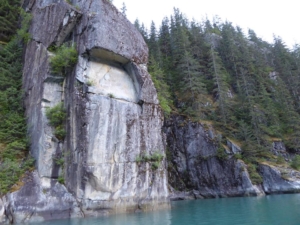
Comprising the largest intact temperate rainforest in the world, Alaska’s Tongass National Forest is a place filled with islands and salmon streams, where towering mountains sweep down into thick old-growth forest and granite cliffs drop into deep fjords Photo credit: Ingrid Ougland
March 25, 2022 – It’s been 30 years since The Wilderness Land Trust protected its first parcel of land. Nearly 25 years later we landed in Alaska, purchasing the largest remaining private inholding in the Chuck River Wilderness in partnership with the Southeast Alaska Land Trust. The 154-acre Windham Bay parcel was transferred to the public for permanent protection almost exactly a year ago.
Together we are now working to protect more wilderness in Alaska. The Kootznoowoo (Fortress of the Bears) and Chuck River Wilderness areas in the Tongass National Forest surround the Inside Passage waterway, connecting more than 2.2 million acres of public land. The size and connectivity of these wild lands filled with coastal rivers and rare muskeg wetlands provide a high level of resilience in the face of climate change that allow grizzlies, salmon, mountain goats, wolves and humpback whales to thrive. The Tlingit village of Angoon on Admiralty Island is home to more than 500 people. Several other rural communities, including the nearby village of Kake, depend on these wilderness areas for subsistence harvests.
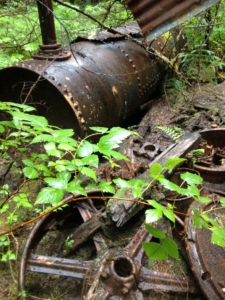
Old mining equipment in the Chuck River Wilderness
Within the 2.2 million acres of public land, clusters of private lands left over from old mining camps exist, threatening the surrounding wilderness with the prospect of timber and mineral extraction as well as residential development.
The Wilderness Land Trust is now working to acquire two properties to prevent cabin development along Wheeler Creek and the Chuck River in the Kootznoowoo and Chuck River Wilderness areas, protecting the salmon, grizzly and black bears that call them home. When this work is complete, a total of 33 acres of new wild lands will be added to the Tongass National Forest and permanently protected from private development, safeguarding more than 2.2 million acres of public land they impact.
Please take the time to learn more about our work in Alaska and join our fight to save this extraordinary wilderness. If you’ve already joined our Alaska campaign, thank you for your support. We cannot do this work without you.
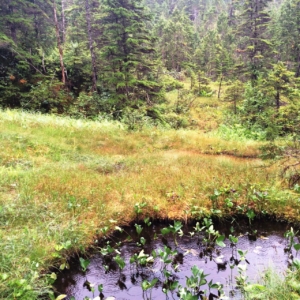
A Muskeg wetland in the Chuck River Wilderness. These wetlands tend to have a water table near the surface and the sphagnum moss forming in it can hold 15 to 30 times its own weight in water, making it an ideal habitat for a wide variety of plant and animal species.
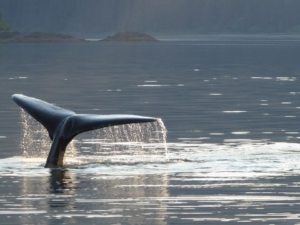
A common sight along Southeast Alaska’s inside passage.
More Protection in the Holy Cross Wilderness
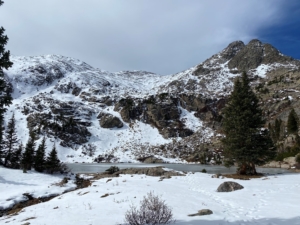
From Hercules Lode looking at Fancy Lake in the Holy Cross Wilderness
March 11, 2022 – Today we closed on two more parcels in the Holy Cross Wilderness of Colorado. These properties, the Chance and Hercules Lodes, total 25 acres and are located on the southwest side of the wilderness.
I had the good fortune of visiting these properties with my cousin, who happens to live close by. Until that day, my cousin was unfamiliar with my job and so, as we hiked past the wooden Holy Cross Wilderness sign, I described the mission of The Wilderness Land Trust and why our work is important. I told her that, while the ground we were walking on is thought to have the highest level of land protection, there are actually significant holes in that protection.
When we reached the first of the two parcels, the flat, beautiful 5-acre Hercules Lode which runs along the east shore of Fancy Lake, my cousin was shocked.
“This is private property?!”
I explained that these pieces of private land are not only a threat because of the opportunities for cabins to be built, mines dug, trees felled. They are a threat because they siphon off resources otherwise used to manage the surrounding wilderness. Their mere existence degrades the integrity of the wilderness area.
The good news is, The Wilderness Land Trust has a way to remove this threat and make our wilderness areas truly protected.
We’ve been at it for 30 years.
In Colorado alone, we have protected more than 6,000 acres of private land and the innumerable acres of surrounding public land with our work.
And today, we can add another 25 acres to that number.
We are grateful for all of our supporters who make our work protecting wilderness possible. We truly couldn’t do it without you.
-Kelly Conde, Wilderness Land Trust Lands Specialist
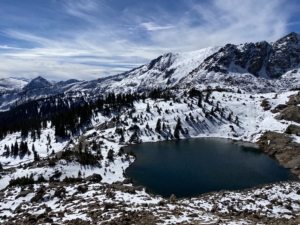
View of Mulhall Lake from Chance Lode
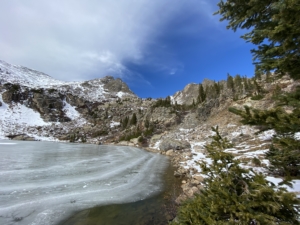
Photo of Hercules Lode which runs along the east side of Fancy Lake in the Holy Cross Wilderness
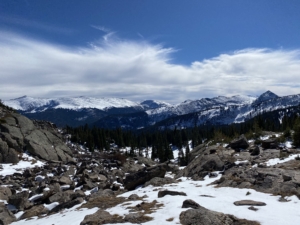
Looking down on the southeast corner of the Holy Cross Wilderness on the hike to Chance Lode
More Protection for Wilderness in Colorado
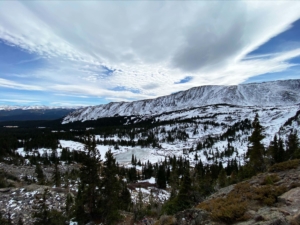
A spectacular view from the Northern Lode property
Feb. 25, 2022 – Today, The Wilderness Land Trust closed on the Northern Lode property, a 10-acre parcel on the eastern side of the Holy Cross Wilderness in Colorado. The Northern Lode is a true wilderness inholding, meaning it is completely surrounded by federally designated wilderness and will automatically become a new addition to the Holy Cross upon transfer.
I visited this property on a crisp, sunny day last October. The parcel is a three-mile trek into the wilderness area and sits just south of the 13,000-foot Homestake Peak on a steep, scree-filled slope.
As with every project site visit, this trip was a combination of pleasure and work. I got to punch through the first snow of the season, scramble up rocky slopes and soak in rugged ridgelines. I also investigated the remnants of old mining pits just off the property boundary and checked off another step towards acquisition. This trip ended up being my last wilderness hike of the year, closing another season of mountain wandering.
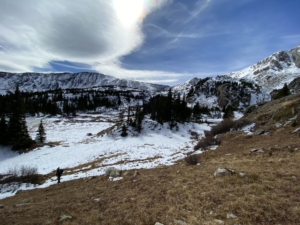 So now, in mid-winter, this property sits close in my mind and makes its acquisition that much sweeter to me.
So now, in mid-winter, this property sits close in my mind and makes its acquisition that much sweeter to me.
We are so grateful to all of our supporters for helping us continue this great work. To date, we have protected 6,086 acres in Colorado and are actively working on acquiring another 55 acres in this state. Please check out our current Colorado work online and stay tuned for more good news from across the western United States!
-Kelly Conde, Wilderness Land Trust Lands Specialist
The Trust Celebrates its 30th With a Successful Project Where It All Began
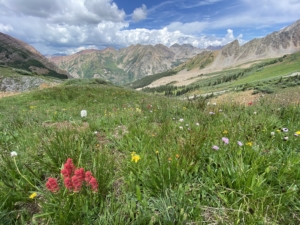
The view from the Trust’s Copper Glance Lode property
Feb. 4, 2022 – In 1992, attorney Jon Mulford worked with the U.S Forest Service (USFS) on several small land transactions outside of Aspen, Colorado. Through this experience, he discovered that private inholdings within the boundaries of federally designated wilderness were posing environmental threats to the landscape and creating management issues for the agency.
This information inspired Jon to develop a plan to acquire private properties within the wilderness designation and turn them over to public ownership. His vision was a national wilderness preservation system free from the threat of human development.
On February 6, 1992, Jon founded The Wilderness Land Trust to fulfill his vision. Since that time, The Trust has acquired and transferred 514 properties totaling 54,110 acres throughout the west, including 6,077 acres in Colorado.
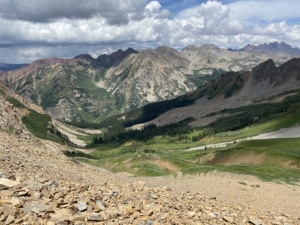
The Trust’s Copper Glance Lode property
As the staff lead for projects in Colorado, I am honored to announce the purchase of our latest inholding where it all started. The Copper Glance Lode is a 10.33-acre property in the Maroon Bells-Snowmass Wilderness. This parcel sits in the scenic Queens Basin and was part of the former Copper Glance mining operation. With the Trust’s purchase of this parcel, Queens Basin is now free of the threat of development.
This year, The Wilderness Land Trust celebrates its 30th anniversary. I reached out to Jon Mulford and asked him for his thoughts. His response was simple, “Keep up the good work.” On behalf of our entire staff and board, we want to express how grateful we are to our supporters, project partners, agency staff and landowners who make our mission to protect wilderness possible.
Thank you Jon, for starting us on this journey. We promise to keep up the good work.
-Kelly Conde, Wilderness Land Trust Lands Specialist
The Wilderness Land Trust Adds 880 acres to the Mt. Biedeman Wilderness Study Area
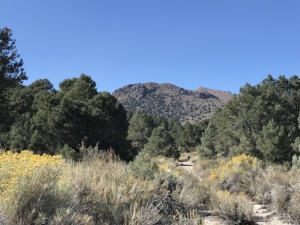
A trail with a stunning view of Mt. Biedeman meanders through the Trust’s newly acquired Bodie Hills property
Bodie Hills land purchase means additional protection for California’s Eastern Sierra
Jan. 20, 2022 – The Wilderness Land Trust has closed on an 880-acre land purchase in the Bodie Hills, located in California’s Eastern Sierra. The Trust is now working with the Bureau of Land Management (BLM) and its conservation partners to permanently protect this property.
Overlooking Mono Lake and the Eastern Sierra on the south side of the Mt. Biedeman Wilderness Study Area (WSA), the Trust’s Bodie Hills property is known for its mature pinon-juniper forest and seasonal streams. The Bodie Hills link the Sierra Nevada to the high desert plains and wetlands of the Great Basin in California and Nevada. The size and connectivity of these wild lands provide a high level of resilience in the face of climate change that allow flora and fauna to thrive. Mule deer herds and pronghorn rely on this property to migrate between their winter and summer habitats. The area also has some of the densest concentrations of cultural and historic sites in the Great Basin.
“By purchasing the Bodie Hills property, we have protected this land from the threat of development and mining, preserved the resilience of the surrounding landscapes and protected access to a truly beautiful spot overlooking Mono Lake and the Eastern Sierra,” says Aimee Rutledge, vice president and senior lands specialist, The Wilderness Land Trust. “A heartfelt thanks to all our supporters and especially to the landowner and our partners – Friends of the Inyo, the Mono Lake Committee, Eastern Sierra Land Trust, DeChambeau Creek Foundation, Wildlands Conservancy and Resources Legacy Fund – for making this acquisition possible.”
“The acquisition of these lands, adjacent to the Mount Biedeman WSA, are an integral piece of the ecological connectivity of the Mono Basin and the Bodie Hills. The justification for permanently protecting this area is made significantly stronger because of unified ownership,” says Jora Fogg, policy director, Friends of the Inyo.
“The scenic beauty of Mono Lake and the Mono Basin National Forest Scenic Area is now better protected thanks to this significant acquisition. This is a great way to start the new year at Mono Lake,” says Geoff McQuilkin, executive director, Mono Lake Committee.
The Wilderness Land Trust has now completed five projects totaling more than 6,500 acres in the Bodie Hills region. However, thousands of acres of private lands still exist within and adjacent to the Bodie Hills, affecting several wilderness study areas, areas of critical environmental concern, and the Granite Mountain Wilderness. Without our efforts to purchase and protect private holdings within these public lands, these wild areas are vulnerable to gold mining, and commercial and residential development that threaten plant and wildlife habitat.
Additional Wilderness Land Trust Bodie Hills Projects
A Unique Ecosystem Worth Saving – Wilderness Land Trust
A Win for Wildlife Habitat in Eastern Sierra – Wilderness Land Trust
